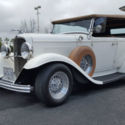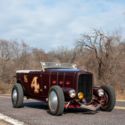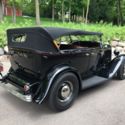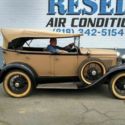1932 Ford Phaeton 4dr Convertible Model B Deluxe
| Make: | Ford |
| Model: | Other |
| Type: | CONVERTIBLE |
| Year: | 1932 |
| Mileage: | 5,579 |
| VIN: | 18112957 |
| Color: | Purple |
| Engine: | Flat Head V8 85 HP |
| Cylinders: | 8 |
| Fuel: | Gasoline |
| Transmission: | Manual |
| Drive type: | 191 |
| Interior color: | Brown |
| Vehicle Title: | Clear |
| Item location: | College Place, Washington, United States |
1932 Ford Other Additional Info:
Untitled Document AUTOCHOICE Is Yours.com, LLC 5095259782 / (509) 525-9782| 1932 Ford Phaeton 4dr Convertible Model B Deluxe |
| 1932 Ford Phaeton 4dr Convertible Model B Deluxe | |
| Purple / Brown 5,579 Miles / VIN: 18112957 |
at 5095259782 / (509) 525-9782
College Place, WA 99324
View This Seller's Other Auctions
| Purple Exterior / Brown Interior | VIN: 18112957 |
| 4 Doors, Convertible, 8 Cylinders, Manual | Inventory ID: D092916 |
Always a pleasure for AUTOCHOICE to represent classic cars that have been restored to perfection. WOW what a fine example with this 1932 Ford Deluxe Phaeton 4dr Convertible! This car is a "one" I invite you to scrutinize all 144 photos carefully, and you will find this car is perfect in every way. Words absolutely can not describe properly this classic.... You will stand anywhere near this car and just be in awe,,, it is a jaw dropping experience is about all I can say. Call Don today to schedule an appointment to view this car for yourself in person. You will not want to leave until you have purchased it. Call Don at (509) 301-1498 today!
FYI you will find the following information about the 32 models and the famous flat-head V8.
When Ford introduced the Model A in late 1927, there were several competitors also offering four cylinder cars, among them Chevrolet, Dodge, Durant, or Willys. That changed within a few years, soon leaving the new Plymouth the sole major make in the Ford's price class with a four.
Although sharing a common platform, ModelBs and Model18s came not only in Standard and Deluxe trim, they were available in a large variety of body styles. Some of them, like the commercial cars described below, were only available as Standards, and a few other came only in Deluxe trim. There were two-door roadster, two-door cabriolet, four-door phaeton, two-door and four-door sedans, four-door 'woodie" station wagon, two-door Victoria, two-door convertible sedan, panel and sedan deliveries, five-window coupe, a sport coupe (stationary softtop), the three-window Deluxe Coupe, and pickup. The wooden panels were manufactured at the Ford Iron Mountain Plant in the Michigan Upper Peninsula from Ford owned lumber.
Prices ranged from US$495[1] for the roadster, $490 for the coupes, and $650 for the convertible sedan. Production totals numbered from 12,597 for the roadster to 124,101 for the two-door sedan. Ford sold 298,647 V8-powered 18s in 1932,[2] and except for the fact Ford could not keep up with demand, the essentially identical four-cylinder B would have been a sales disaster: dealers switched customers to them from the V8, and even then sold only 133,539,[2] in part because the V8 cost just US$10 more.[2]
The B was discontinued because buyers disliked four cylinder models in general, and because of the huge success of the V-8, not for being an inferior car. In fact, it persisted a little longer in Europe, where in many countries the tax system heavily favored smaller-displacement engines.
Today, the 1932 ModelB, although always a little bit in the shadow of the V-8, is a highly collectible car and people will pay thousands of dollars to restore one to original specification.
All 1932 Fords—V8-8s and Model Bs—came with black fenders, wire wheels, and a rear-mounted spare wheel (side mount on cars equipped with a tail gate). Options included single or twin sidemounts, luggage rack, clock, in- and outside mirrors, and choice of leather or Broadcloth (closed cars) interior material.
Paints were Pyroxylin lacquer.[3]
Standard & Deluxe trimThe B shared frame, bodies, and even most of the trim with the eight cylinder car. The only technical difference was the use of the slightly reworked Model A engine, thus the designation B. Most body styles were available as Standard or Deluxe variants with either engine offered as an option. Customers could get a deluxe version of the 1932 Model B in three-window coupe (which only came in deluxe model), roadster, phaeton, Tudor and Fordor as well.[4]
Standard trim meant black front window frame, black wire wheels (color optional), black horn (chrome-plated optional), single tail light (2nd optional), painted dash, position lights integrated in the head lamps (Deluxe cowl lamps optional), and less expensive interiors.
The Ford flathead V8 (often called simply the Ford flathead, flathead Ford, or flatty when the context is implicit, such as in hot-rodding) is a V8 engine of the valve-in-block type designed by the Ford Motor Company and built by Ford and various licensees. During the engine's first decade of production, when overhead-valve engines were rare, it was usually known simply as the Ford V‑8, and the first car model in which it was installed, the Model 18, was (and still is) often called simply the "Ford V‑8", after its new engine. Although the V8 configuration was not new when the Ford V8 was introduced in 1932, the latter was a market first in the respect that it made an 8-cylinder affordable and a V engine affordable to the emerging mass market consumer for the first time. It was the first independently designed and built V8 engine produced by Ford for mass production, and it ranks as one of the company's most important developments.[1] A fascination with ever-more-powerful engines was perhaps the most salient aspect of the American car and truck market for a half century, from 1923 until 1973. The Ford flathead V8 was perfectly in tune with the cultural moment of its introduction, leading the way into a future of which the Ford company was a principal architect. Thus it became a phenomenal success. The engine design, with various changes but no major ones,[2] was installed in Ford passenger cars and trucks until 1953, making the engine's 21-year production run for the U.S. consumer market longer than the 19-year run of the Ford Model T engine[2] for that market. The engine was on Ward's list of the 10 best engines of the 20th century. It was a staple of hot rodders in the 1950s, and it remains famous in the classic car hobbies even today, despite the huge variety of other popular V8s that followed.
| ||||||||||||||||
All Original - Unmolested
Clean Title
Always garaged.
Low mileage.
Never seen snow.
New paint.
New tires.
No accidents.
Non-smoker.
Runs & drives great.
Very clean interior.
Additional PhotosEquipment & Features Optional Equipments
| |
Exterior
| Interior
| Mechanical
|












